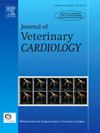确定最佳动态心电图监测持续时间检测室性心律失常在狗:贝叶斯方法
IF 1.3
2区 农林科学
Q2 VETERINARY SCIENCES
引用次数: 0
摘要
本研究的目的是确定动态心电图(Holter)监测检测室性心律失常(VAs)的最佳持续时间,并使用7天记录评估犬的日常自发变异性。动物、材料和方法回顾性分析连续7天动态心电图监测犬的医疗记录。如果狗狗在崩溃、心律失常相关症状或既往心电图记录的VAs中进行了动态心电图监测,则纳入研究。排除进行常规犬种筛选或评估慢速性心律失常或室上性心动过速的犬。使用变异百分比系数(CV%)评估VA负担的日常变异性。贝叶斯概率模型用于分析从第1天到第7天的心律失常检测,确定额外监测提供的诊断回报递减的点。结果124份动态心电图记录中,87份符合纳入标准。每日室性早衰(VPC)频率的百分比变异系数(CV%)范围为8 ~ 188%。贝叶斯分析显示,在监测的前三天内,VPCs的检出率增加,VPCs的检出率增加,室性心动过速发作增加,此后改善很小。100个vpc的检测在两天后趋于稳定。从第4天到第5天,R-on-T淋巴细胞的检出率持续上升。服用抗心律失常药物的狗在第三天达到稳定状态,而未服用药物的狗在第五天的检测结果持续上升。局限性:该研究的回顾性、对治疗犬的适度样本量以及抗心律失常方案的可变性可能限制了普遍性。结论大多数犬的动态心电图监测时间建议为3天,而R-on-T事件检测可能需要4天。本文章由计算机程序翻译,如有差异,请以英文原文为准。
Determining the optimal Holter monitoring duration for detecting ventricular arrhythmia in dogs: a Bayesian approach
Introduction/Objectives
The objective of this study was to determine the optimal duration of ambulatory electrocardiography (Holter) monitoring for detecting ventricular arrhythmias (VAs) and to assess day-to-day spontaneous variability in dogs using seven-day recordings.
Animals, Materials, and Methods
Medical records of dogs undergoing the consecutive seven-day Holter monitoring were retrospectively reviewed. Dogs were included if the Holter monitoring was performed for collapse, arrhythmia-related symptoms, or documented VAs on prior electrocardiography. Dogs undergoing routine breed screening or evaluated for bradyarrhythmias or supraventricular tachycardia were excluded. Day-to-day variability in VA burden was assessed using the percent coefficient of variation (CV%). Bayesian probability modeling was used to analyze arrhythmia detection from days one through seven, identifying the point at which additional monitoring provided diminishing diagnostic returns.
Results
Of 124 Holter recordings reviewed, 87 met inclusion criteria. The percent coefficient of variation (CV%) for daily ventricular premature complex (VPC) frequency ranged from 8 to 188%. Bayesian analysis showed that detection of >1000 VPCs, >500 VPCs, or ventricular tachycardia episodes increased within the first three days of monitoring, with minimal improvement thereafter. Detection of >100 VPCs plateaued after two days. R-on-T VPCs exhibited continued detection increases through days four to five. Dogs receiving anti-arrhythmic drugs plateaued by day three, whereas untreated dogs showed continued detection increases up to day five.
Limitations
The study's retrospective nature, modest sample size for treated dogs, and variability in anti-arrhythmic protocols may limit generalizability.
Conclusions
A three-day Holter monitoring duration is recommended for detecting most VAs in dogs, while four days may be required for R-on-T event detection.
求助全文
通过发布文献求助,成功后即可免费获取论文全文。
去求助
来源期刊

Journal of Veterinary Cardiology
VETERINARY SCIENCES-
CiteScore
2.50
自引率
25.00%
发文量
66
审稿时长
154 days
期刊介绍:
The mission of the Journal of Veterinary Cardiology is to publish peer-reviewed reports of the highest quality that promote greater understanding of cardiovascular disease, and enhance the health and well being of animals and humans. The Journal of Veterinary Cardiology publishes original contributions involving research and clinical practice that include prospective and retrospective studies, clinical trials, epidemiology, observational studies, and advances in applied and basic research.
The Journal invites submission of original manuscripts. Specific content areas of interest include heart failure, arrhythmias, congenital heart disease, cardiovascular medicine, surgery, hypertension, health outcomes research, diagnostic imaging, interventional techniques, genetics, molecular cardiology, and cardiovascular pathology, pharmacology, and toxicology.
 求助内容:
求助内容: 应助结果提醒方式:
应助结果提醒方式:


